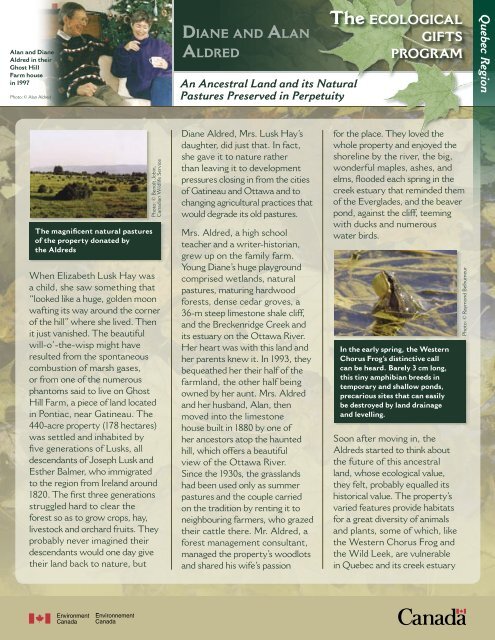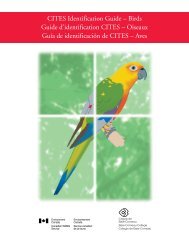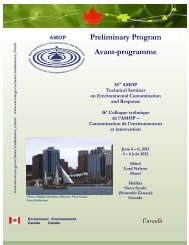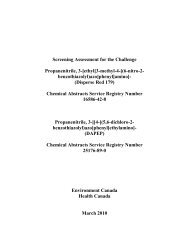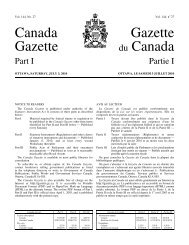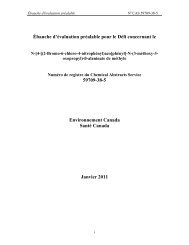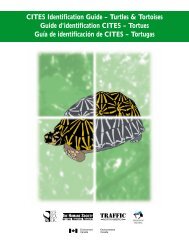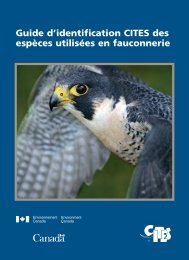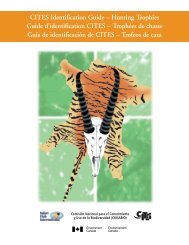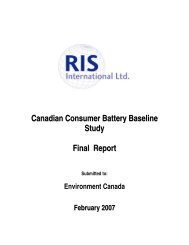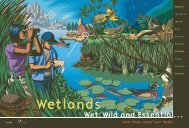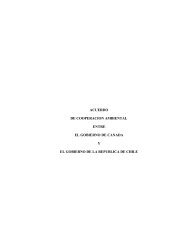DIANE AND ALAN ALDRED
DIANE AND ALAN ALDRED
DIANE AND ALAN ALDRED
You also want an ePaper? Increase the reach of your titles
YUMPU automatically turns print PDFs into web optimized ePapers that Google loves.
Alan and Diane<br />
Aldred in their<br />
Ghost Hill<br />
Farm house<br />
in 1997<br />
Photo: © Alan Aldred<br />
The magnificent natural pastures<br />
of the property donated by<br />
the Aldreds<br />
Photo: © Benoît Jobin,<br />
Canadian Wildlife Service<br />
When Elizabeth Lusk Hay was<br />
a child, she saw something that<br />
“looked like a huge, golden moon<br />
wafting its way around the corner<br />
of the hill” where she lived. Then<br />
it just vanished. The beautiful<br />
will-o’-the-wisp might have<br />
resulted from the spontaneous<br />
combustion of marsh gases,<br />
or from one of the numerous<br />
phantoms said to live on Ghost<br />
Hill Farm, a piece of land located<br />
in Pontiac, near Gatineau. The<br />
440-acre property (178 hectares)<br />
was settled and inhabited by<br />
five generations of Lusks, all<br />
descendants of Joseph Lusk and<br />
Esther Balmer, who immigrated<br />
to the region from Ireland around<br />
1820. The first three generations<br />
struggled hard to clear the<br />
forest so as to grow crops, hay,<br />
livestock and orchard fruits. They<br />
probably never imagined their<br />
descendants would one day give<br />
their land back to nature, but<br />
<strong>DIANE</strong> <strong>AND</strong> <strong>ALAN</strong><br />
<strong>ALDRED</strong><br />
An Ancestral Land and its Natural<br />
Pastures Preserved in Perpetuity<br />
Diane Aldred, Mrs. Lusk Hay’s<br />
daughter, did just that. In fact,<br />
she gave it to nature rather<br />
than leaving it to development<br />
pressures closing in from the cities<br />
of Gatineau and Ottawa and to<br />
changing agricultural practices that<br />
would degrade its old pastures.<br />
Mrs. Aldred, a high school<br />
teacher and a writer-historian,<br />
grew up on the family farm.<br />
Young Diane’s huge playground<br />
comprised wetlands, natural<br />
pastures, maturing hardwood<br />
forests, dense cedar groves, a<br />
36-m steep limestone shale cliff,<br />
and the Breckenridge Creek and<br />
its estuary on the Ottawa River.<br />
Her heart was with this land and<br />
her parents knew it. In 1993, they<br />
bequeathed her their half of the<br />
farmland, the other half being<br />
owned by her aunt. Mrs. Aldred<br />
and her husband, Alan, then<br />
moved into the limestone<br />
house built in 1880 by one of<br />
her ancestors atop the haunted<br />
hill, which offers a beautiful<br />
view of the Ottawa River.<br />
Since the 1930s, the grasslands<br />
had been used only as summer<br />
pastures and the couple carried<br />
on the tradition by renting it to<br />
neighbouring farmers, who grazed<br />
their cattle there. Mr. Aldred, a<br />
forest management consultant,<br />
managed the property’s woodlots<br />
and shared his wife’s passion<br />
The ECOLOGICAL<br />
GIFTS<br />
PROGRAM<br />
for the place. They loved the<br />
whole property and enjoyed the<br />
shoreline by the river, the big,<br />
wonderful maples, ashes, and<br />
elms, flooded each spring in the<br />
creek estuary that reminded them<br />
of the Everglades, and the beaver<br />
pond, against the cliff, teeming<br />
with ducks and numerous<br />
water birds.<br />
In the early spring, the Western<br />
Chorus Frog’s distinctive call<br />
can be heard. Barely 3 cm long,<br />
this tiny amphibian breeds in<br />
temporary and shallow ponds,<br />
precarious sites that can easily<br />
be destroyed by land drainage<br />
and levelling.<br />
Soon after moving in, the<br />
Aldreds started to think about<br />
the future of this ancestral<br />
land, whose ecological value,<br />
they felt, probably equalled its<br />
historical value. The property’s<br />
varied features provide habitats<br />
for a great diversity of animals<br />
and plants, some of which, like<br />
the Western Chorus Frog and<br />
the Wild Leek, are vulnerable<br />
in Quebec and its creek estuary<br />
Photo: © Raymond Belhumeur<br />
Quebec Region
shelters some of the rare Cork<br />
Elm and Black Maple forest<br />
stands in Quebec. In 1997,<br />
motivated by friends who had<br />
donated a piece of land that<br />
became part of a provincial park<br />
in British Colombia, Mrs. Aldred<br />
contacted Environment Canada’s<br />
Canadian Wildlife Service (CWS)<br />
to find out if their property was<br />
worthy of protection. The CWS<br />
then contacted the Nature<br />
Conservancy of Canada (NCC)<br />
in Quebec, who conducted<br />
several biological surveys on the<br />
property over the next few years<br />
to document its diversity and<br />
richness. In 2001, NCC acquired<br />
Mrs. Aldred’s aunt’s undivided<br />
half interest of the land and a<br />
few months later the Aldreds<br />
started to work on a donation<br />
agreement for their part. They<br />
both felt that to be connected<br />
to nature was very important<br />
for human beings and wanted<br />
the farmland to be permanently<br />
protected as a nature preserve.<br />
In the course of the donation<br />
process, they learned, among<br />
other things, that their pastures<br />
dotted with hawthorns offer<br />
a suitable environment for the<br />
Eastern Loggerhead Shrike,<br />
an endangered bird in Canada.<br />
The population of this species<br />
has greatly decreased during the<br />
past decades and an experimental<br />
reintroduction program has<br />
recently started in the hope<br />
of helping its recovery.<br />
Diane Aldred unexpectedly<br />
passed away in 2003, before<br />
<strong>DIANE</strong> <strong>AND</strong> <strong>ALAN</strong> <strong>ALDRED</strong><br />
her precious legacy to future<br />
generations was completed.<br />
But the year after, according<br />
to her wish, her husband made<br />
the ecological donation of the<br />
ancestral land to the Nature<br />
Conservancy of Canada (NCC) 1<br />
and to the Province of Quebec<br />
Society for the Protection of Birds<br />
(PQSPB) 2 , two private nonprofit<br />
organizations dedicated<br />
to nature protection. The<br />
donation was made according to<br />
Environment Canada’s Ecological<br />
Gifts Program, which provides<br />
a tax break and a reduction in<br />
the taxable capital gain for gifts<br />
of ecologically sensitive land or<br />
partial interests in land. “For<br />
us, the tax benefits were not so<br />
important, since we had no gain<br />
in capital to pay, but this program<br />
is a wonderful thing, because<br />
it encourages people to make a<br />
donation,” Mr. Aldred explains.<br />
Diane Aldred<br />
Photo: © Alan Aldred<br />
Diane Aldred’s favourite thing<br />
was to walk the homestead. She<br />
was especially concerned with<br />
the fate of its natural pastures<br />
and the myriad of animals that<br />
live or hunt there, be they a<br />
Western Chorus Frog, an Eastern<br />
Meadowlark, a Bobolink or a<br />
Red-tailed Hawk. “I could not<br />
live with the knowledge of the<br />
wholesale destruction that would<br />
follow in the wake of a bulldozer,”<br />
she once wrote. Thanks to the<br />
unfailing support of her husband<br />
Alan, her dream to protect Ghost<br />
Hill Farm’s beautiful landscapes,<br />
varied habitats and numerous wild<br />
species was accomplished. Her<br />
ancestors can rest in peace, since<br />
the pastures left by their many<br />
decades of backbreaking work<br />
will be preserved as well as the<br />
ghost-creating marshes.<br />
With its contrasting plumage,<br />
aerial displays and inimitable<br />
song, the male Bobolink, a<br />
common field species, does not<br />
only attract the attention of the<br />
females it is courting.<br />
For more information on<br />
ecological gifts, please contact:<br />
The Ecological Gifts Program<br />
Canadian Wildlife Service<br />
Environment Canada<br />
Quebec Region<br />
1141 Route de l’Église, P. O. Box 10100<br />
Sainte-Foy, Quebec<br />
G1V 4H5<br />
Tel.: 1-800-463-4311<br />
E-mail: quebec.scf@ec.gc.ca<br />
1 www.natureconservancy.ca<br />
2 www.pqspb.org<br />
ISBN: 978-0-662-44769-6<br />
Cat. no.: CW66-266/1-2007E<br />
© Her Majesty the Queen in Right of Canada, represented by the Minister of the Environment, 2007<br />
Photo: © Samuel Belleau<br />
Ce document est également disponible en français<br />
This paper contains 100%<br />
post-consumer recycled fibres.


